BY LETTER
Ran (Epsilon Eridani)
Galactography > Regions of Space > Inner Sphere
Galactography > Systems and Worlds > Systems & Worlds Q - R
Science > Biology > Xenobiology
Galactography > Systems and Worlds > Systems & Worlds Q - R
Science > Biology > Xenobiology
Birthplace of the Eridanus League | |
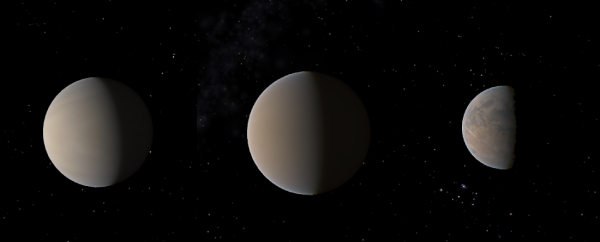 Image from Steve Bowers and The Astronomer | |
| The terrestrial planets Hroenn, Bara and Unn in this system. Bara and Unn are both host to microbial xenobiota. | |
Table of Contents
Ran - Data Panel | |
| System | Names: Ran (Lanxingxi, Laan Shiin Shii, Eridan Ran) Location: - Distance from Nova: 5.465 ly (J2000) - Distance from Sol: 10.50 ly (J2000) - Constellation: Eridanus |
|---|---|
| Star | Names: Ran (Lanxing, Laan Shiin), Epsilon Eridani, 18 Eridani, Gliese 144 (GJ 144), HD 22049, HIP 16537, HR 1084, JD 1452, YTS 0102-1-2 Physical characteristics: - Mass: 1.6E+30 kg (0.82 x Sol) - Radius: 513,000 km (0.738 x Sol) - Spectral type: K2 V - Luminosity: 0.32 x Sol (bolometric) - Temperature: 5,052 Kelvin - Rotation period: 11.4 days - Age: 800 million years System: Ran and its planets were named during the Information Age after figures from the Norse mythology of the old Earth. 1) Dufa: This world has been converted into a computronium node. At time of discovery, Dufa had the following characteristics: Videntian Sulfoli-Terrestrial Lapi-Minervan Azo-Cytherean - Semi-major axis = 0.201 AU - Orbital period = 35.27 days - Eccentricity = 0.000 - Mass = 0.526 x Earth - Radius = 0.823 x Earth 2) Hroenn: Videntian Hydro-Terrestrial Lapi-Ydratian Aqua-Cytherean - Semi-major axis = 0.336 AU - Orbital period = 78.56 days - Eccentricity = 0.024 - Mass = 0.773 x Earth - Radius = 0.930 x Earth 3) Bara: Hydro-Terrestrial Lapi-Minervan Capno-Cytherean - Semi-major axis = 0.534 AU - Orbital period = 157.4 days - Eccentricity = 0.026 - Mass = 1.141 x Earth - Radius = 1.064 x Earth 4) Unn: Terrestrial Lapi-Rhean Aqua-Arean - Semi-major axis = 0.712 AU - Orbital period = 242.3 days - Eccentricity = 0.027 - Mass = 0.407 x Earth - Radius = 0.774 x Earth Huru Band: Orbital band - Radius = 1.795 AU 5) Ægir: Aithali-Jovian Hydrogeo-Barian, completely enveloped by computation suprashell. - Semi-major axis = 3.53 AU - Orbital period = 7.32 years - Eccentricity = 0.06 - Mass = 0.98 x Jupiter - Radius = 11.95 x Earth Second Ran Asteroid Belt: - Inner radius = 10 AU - Outer radius: 17 AU 6) Hefring: Cryoazuri-Neptunian Geli-Jotunnian Hydrogeo-Barian - Semi-major axis = 26.19 AU - Orbital period = 148.0 years - Eccentricity = 0.035 - Mass = 18.59 x Earth - Radius = 4.715 x Earth 7) Himinglaeva: Hydro-Jovian Hydrogeo-Barian, partially enveloped by computation suprashell. - Semi-major axis = 47.83 AU - Orbital period = 374.2 years - Eccentricity = 0.1 - Mass = 138 x Earth - Radius = 11.01 x Earth Third Ran Asteroid Belt: - Inner radius = 56 AU - Outer radius: 71 AU |
| Reached | 595 AT by the Kelkemesh, a Gengineer Republic starship, followed by the Mayari from the Cislunar Alliance in 603, and the Cinnabar from the Martian Union in 607. |
| Governance and Administration | System polity: Ran Combine Constitution: Poetry of the Star at the Heart of the Terragen Sphere Affiliation: The Ran Combine is staunchly neutral in interstellar politics. Each member polity is free to align with any empire they wish. Overseer: Primarily Archailect Ran (S4), with some input from Speck in the Universe. |
| Population | S0: 259.4 billion S1: 12.88 million S2: 26,695 S3: 80 S4: 3 - Archailect Ran, Speck in the Universe, and Million Worlds Surge |
| Economy and Infrastructure | Local Travel: Primarily boostbeams and conversion drive interplanetary transports. Angelnetting: Ubiquitous, although each member polity has its own configurations that conform to the guidelines provided by the system organization. |
| Travel | Wormhole: Vast Horizon (3,800 m) to Nova (Tau Ceti) Cycler Routes: 4 Hazard rating: 0.0 to 1.0 in most locations Freedom of movement: Certain locations, such as the Ægir Jupiter-brain, are off-limits to modosophonts, each member polity has its own policy on the matter, although most permit free travel. |
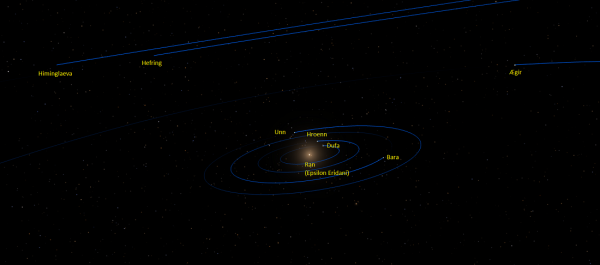 Image from The Astronomer | |
| The planets of the Ran System; Dufa, Hroenn, Bara, Unn, Ægir, Hefring and Himinglaeva. | |
System
Ran boasts a rich system consisting of seven planets, including one gas giant with an extensive moon system, as well as three dense debris disks, typical of young stars. Over the last ten thousand years, its inhabitants have rearranged and utilized these resources in various ways. By the Current Era, the star, its planets, and other structures are in various stages of development.The star Ran itself is the primary location of the Archailect Ran, who has dominion over the star. The starlifting rig guides Ran's stellar wind and mass ejections towards the poles, where the mass is collected and then distributed to various locations. The rate of stellar activity is carefully fine-tuned in order to meet the system's material demands by none other than Archailect Ran emself. As with most other densely inhabited stars, Ran is surrounded by a power collector swarm, arranged in the shape of a toroid, allowing passage of starlifted materials.
Dufa and Hroenn, the two innermost planets, present a curious contrast in development for worlds that were originally quite similar. In the Current Era, Dufa has been converted into a computation node, shared between multiple S3s and many more S2 communities that enjoy engaging in transapient pastime activities considered esoteric by their peers. In contrast, Hroenn appears to be largely spared from development, with most of the modifications done by the modosophont inhabitants, who largely led the same skydweller lifestyles as they had always did, even when the surface of the planet has been cooled and transformed into a lush garden teeming with neogenic lifeforms that find the supercritical water ocean of the world homely.
Bara and Unn are currently best known as the hotspots of contention between several rivaling polities consisting of pseudo-xenosophonts created in virches run by Million Worlds Surge, each competing in a diverse range of activities permitted by the Ran Combine to increase their reputation, and consequently their share in the development of the ril version of their homeworlds. As factions rose and fell in power, the environment and the biospheres of these two planets can be modified over the course of centuries. Currently Bara is a Venus-like world, with a huge number of floating islands and lakes, kept aloft with vacuum dirigibles, while Unn is dried up into a warm desert world with a thin atmosphere and no permanent pools of any kind of liquid on the surface; lifeforms mainly thrive in subsurface caverns, cracks, and tunnels.
The cores of the two largest planets, Ægir and Himinglaeva, have been utilized by two of the system's three archailects as their primary computation nodes. Both planets are currently surrounded by suprashells which function as supplementary processing cores, as well as radiators, energy emitters (whether for energy distribution, message transmission, or system defense), and boostbeam providers. This scheme is being emulated at Hefring, where most of the local S3 transapients plan to merge and transcend into a single S4 entity, the fourth of the system, by the next two hundred years. The satellites of these fare differently; some were left alone for modosophont inhabitation, some were converted into moon-brains that house a number of transapients, and a few were disassembled, partially or completely.
The First Ran Belt had been completely taken apart for construction materials. In its place is an orbital band of Bishop rings and other types of habitats that came to house a significant fraction of the system's modosophont population. The other two belts have not been fully utilized yet; the objects within them have been shepherded into neat circular orbits to maximize ease of usage and minimize wastefulness caused by collisions.
The Ran outer cloud has been completely converted into a system defender cloud, a mass of defensive weaponry stationed in the volume between 3,000 AU to 10,000 AU. This is one of the three major defense systems that protect the Ran system from external threats, the other two being the phased-array emitter surfaces on the suprashells of Ægir and Himinglaeva, and the powerful Nicoll-Dyson beam-projecting elements densely lining the outermost layer of the star's power collector swarm. These three elements form a nigh impenetrable (for entities below S4) fortification colloquially referred to as the Aegis of Ran.
For more details of the Ran system in various eras, see:
Ran system before colonization
Ran (Epsilon Eridani) in 770 AT
Ran system in 945 AT
Ran system in 10600 AT
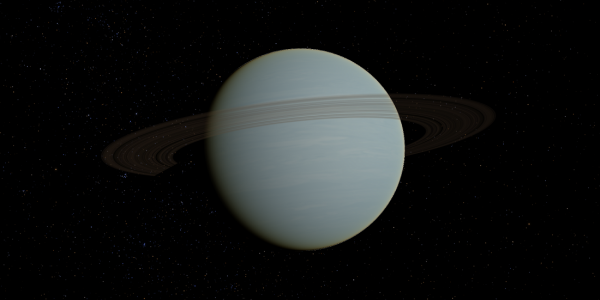 Image from The Astronomer | |
| Hefring, a cold ice giant on the edge of this system. | |
History
As one of the first systems to be settled by Terragens, the Ran system civilization has recently celebrated the ten thousandth Terran years of its history.For details of the history of the Ran system, see this page: Ran (Epsilon Eridani) - History
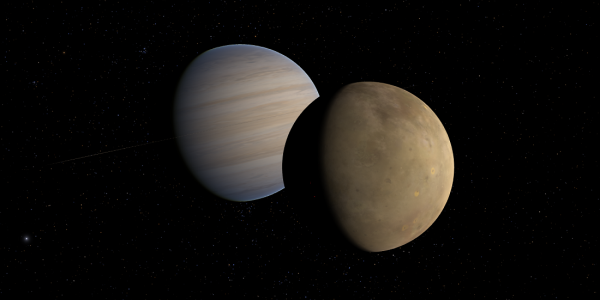 Image from The Astronomer | |
| Ægir and its Io-like moon, Fimafeng, as they appeared when the first colonists arrived into this system. | |
Politics
As typical of old, established systems in the Inner Sphere, the population of the Ran system is split into a large number of polities - 74,794 independent polities in this case. Polities aligned to virtually every empire with presence within the Inner Sphere can all be found. Since emerging from the post-ComEmp chaos during the 59th century, interactions between these polities have been overseen by an organization commonly known as the Ran Combine, which appears to be run by a collection of S3 transapients inhabiting various computation nodes across the system. The Ran Combine is overseen by the Archailect Ran - a slightly eccentric S4 entity who playfully presents emself as the personification of the parent sun - and eir companion, Speck in the Universe, who inhabits the suprashell over Himinglaeva. Neither of them consider themselves as part of the Combine, however.An unaligned, modosophont-friendly S4 entity known as Million Worlds Surge inhabits the Jupiter-brain megastructure enveloping the planet Ægir, where e uses excess computation power to simulate millions of different scenarios of evolution of the biosphere of Bara and Unn, occasionally gifting some of the results, such as the Shanu and the Azith, to the modosophont observers. Some of these pseudo-xenosophonts eventually become powerful forces that drive the dynamism of the modo-level politics of these two worlds.
Unlike its immediate downstream neighbor Nova, all major powers of the Ran system - the archailects and the Ran Combine - are staunchly neutral in interstellar affairs, as showcased by the system's complete lack of military involvement with external conflicts in the last four thousand years. While the Combine gives its member polities freedom to align with any empire, it forbids them from participating in conflicts as well.
Cultures
Some of the most remarkable and influential cultural elements from Ran hailed from its Eridanus League days. Relics such as the Bojiangnese language spawned its own lineage of languages, influences of which can be identified even in the Current Era. Additionally, the proliferation of Etodism within the system, and by extension the Eridanus League, served to ensure the religion's future, even if the faith had returned to obscurity within the Ran system itself since the Age of Establishment.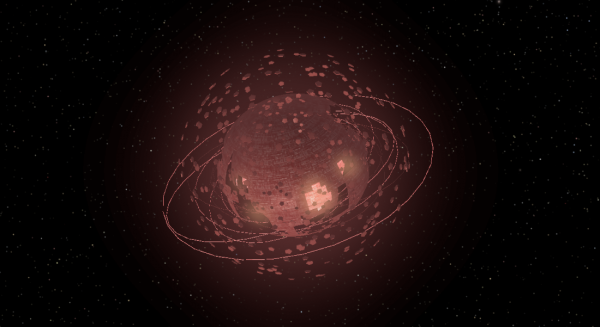 Image from Steve Bowers | |
| In the Current Era, Ægir is in the process of modification to become a Jupiter Brain. | |
In the Current Era, a modification of Hongshanism appears to be championed by the Archailect Ran, whose influence in turn kept the belief alive in the everyday lives of the lower beings within the Ran system, although with a significant degree of variation, from gratitude to the advice that the sun periodically gives out, to the drive to beautify the worlds they live at. Many stories produced by authors in this system, such as Redemption of the Leader-Tribe of M'Anh by Kanshari OmYas'ha Vikraysi, also show clear signs of influence from Hongshanism.
Travel
The Ran system is one of the few systems linked to the Wormhole Nexus through a side branch - wormholes that connect two non-relay systems together. Ran's wormhole was established by the S3s of the two systems in 2561, shortly before wormhole network expansion became consolidated by the emerging archailects. With no particularly compelling reason to remove it, this link was kept. The wormhole connection was shut once during the Version War, largely isolating the system from the Nexus, but at other times it served as the primary gateway to Ran.Related Articles
Appears in Topics
Development Notes
Text by Updated by The Astronomer 2021
From an original article by M. Alan Kazlev. Revised by QwertyYerty 2018 Additional material by Dangerous Safety 2021
Initially published on 24 October 2001.
December 2015: Epsilon Eridani b renamed in line with new IAU nomenclature
2021: Other planets in this system renamed and updated by The Astronomer and dangerous_safety.
From an original article by M. Alan Kazlev. Revised by QwertyYerty 2018 Additional material by Dangerous Safety 2021
Initially published on 24 October 2001.
December 2015: Epsilon Eridani b renamed in line with new IAU nomenclature
2021: Other planets in this system renamed and updated by The Astronomer and dangerous_safety.
Additional Information
Author's Note
In real life, the Ran system has one confirmed planet: Ægir (Epsilon Eridani b), and one planet candidate: Epsilon Eridani c, known in Orion's Arm as Himinglaeva. The system is more notable for its three debris disks. The outer edge of the second disk is used to determine the location of the fictional Neptunian planet of Hefring. The inner planets of this system are completely fictitious.
In real life, the Ran system has one confirmed planet: Ægir (Epsilon Eridani b), and one planet candidate: Epsilon Eridani c, known in Orion's Arm as Himinglaeva. The system is more notable for its three debris disks. The outer edge of the second disk is used to determine the location of the fictional Neptunian planet of Hefring. The inner planets of this system are completely fictitious.






